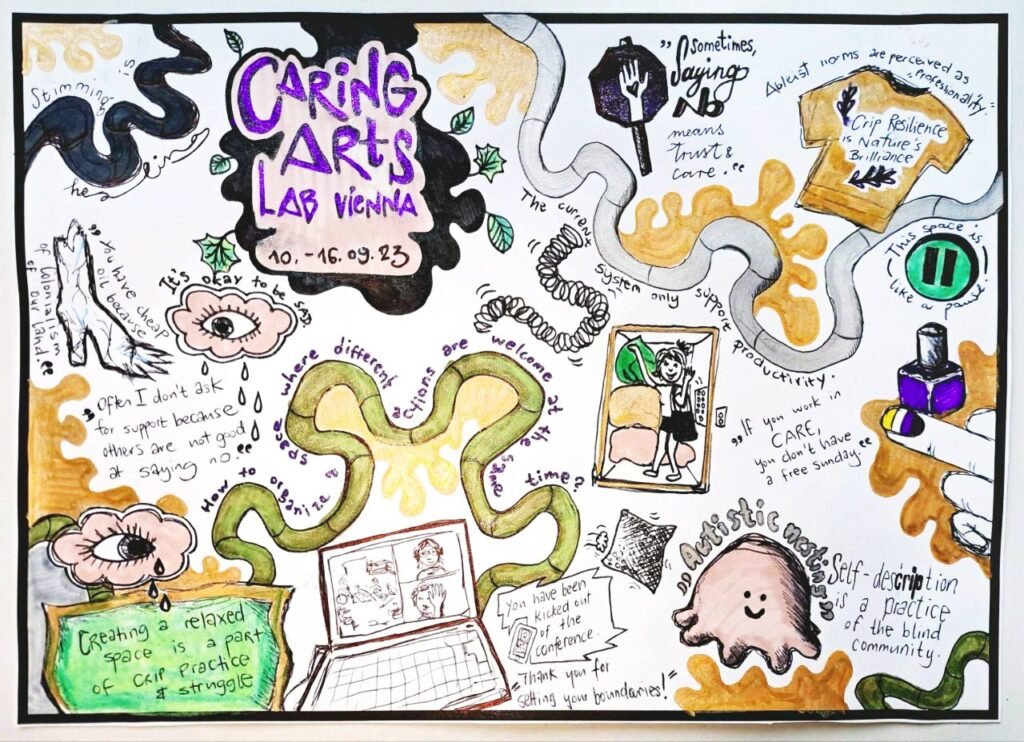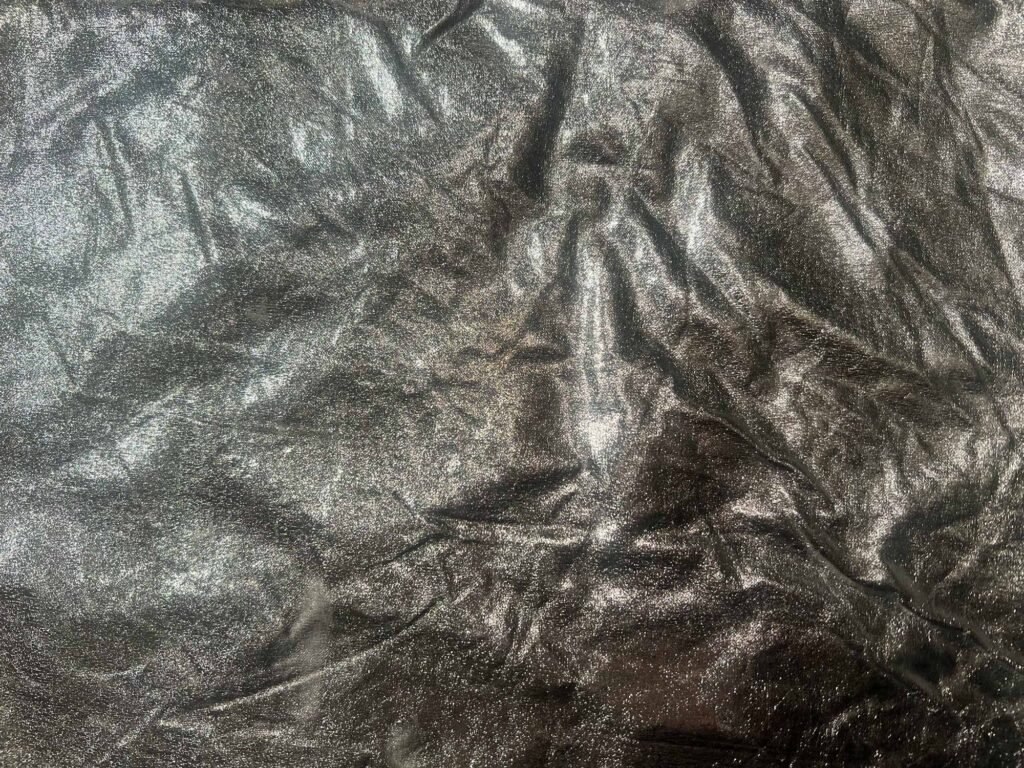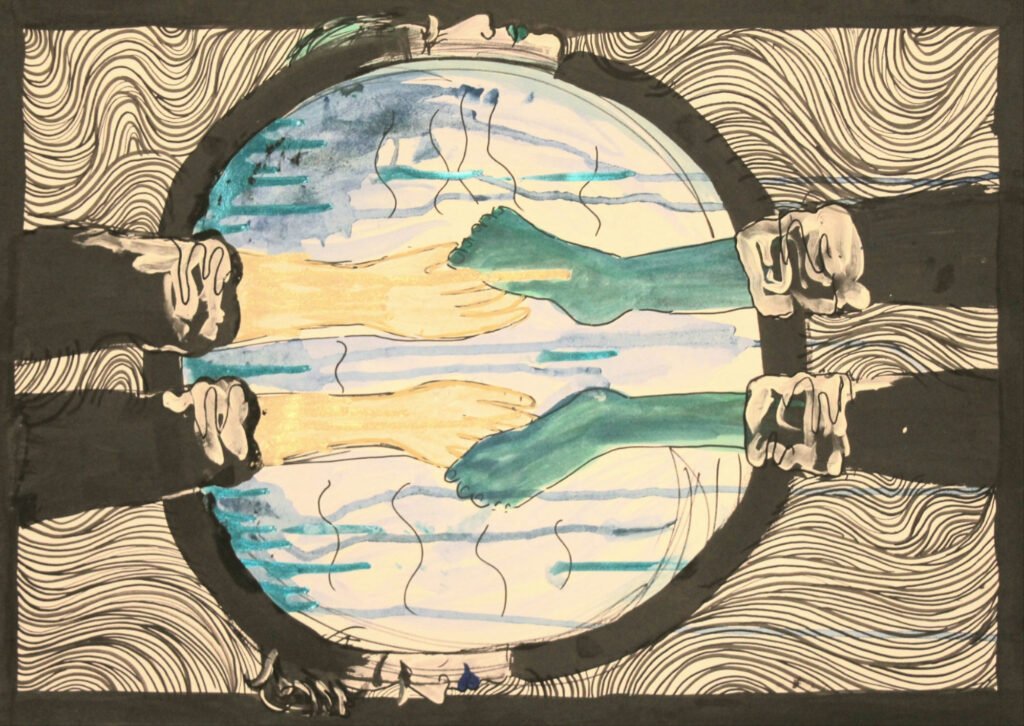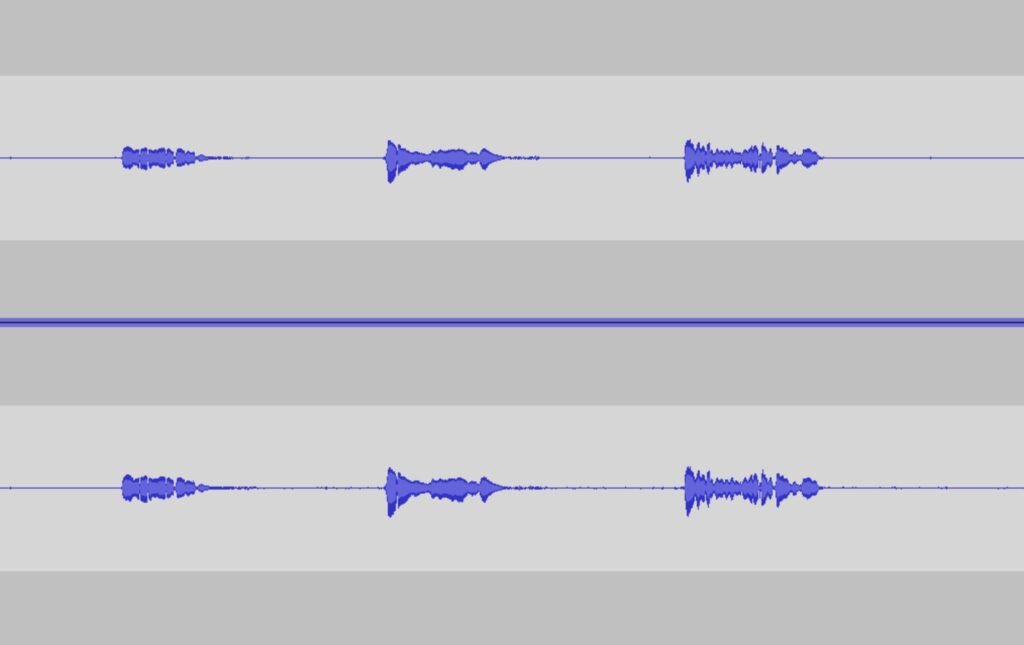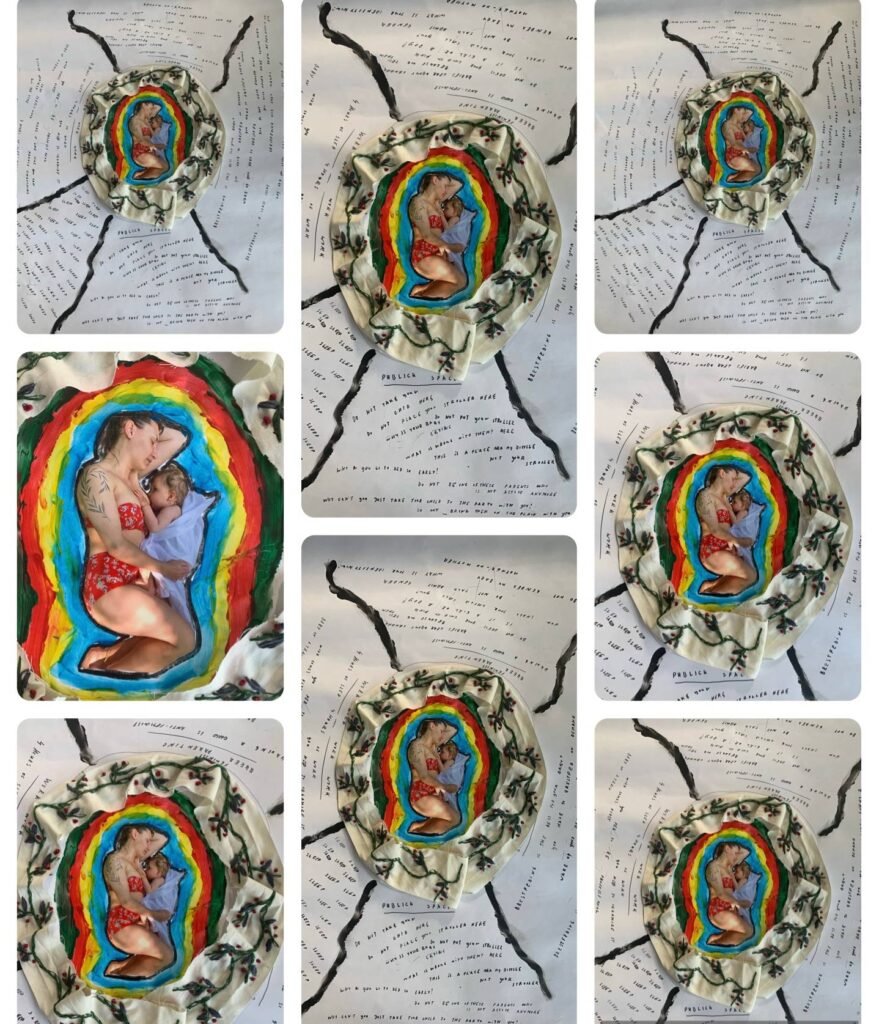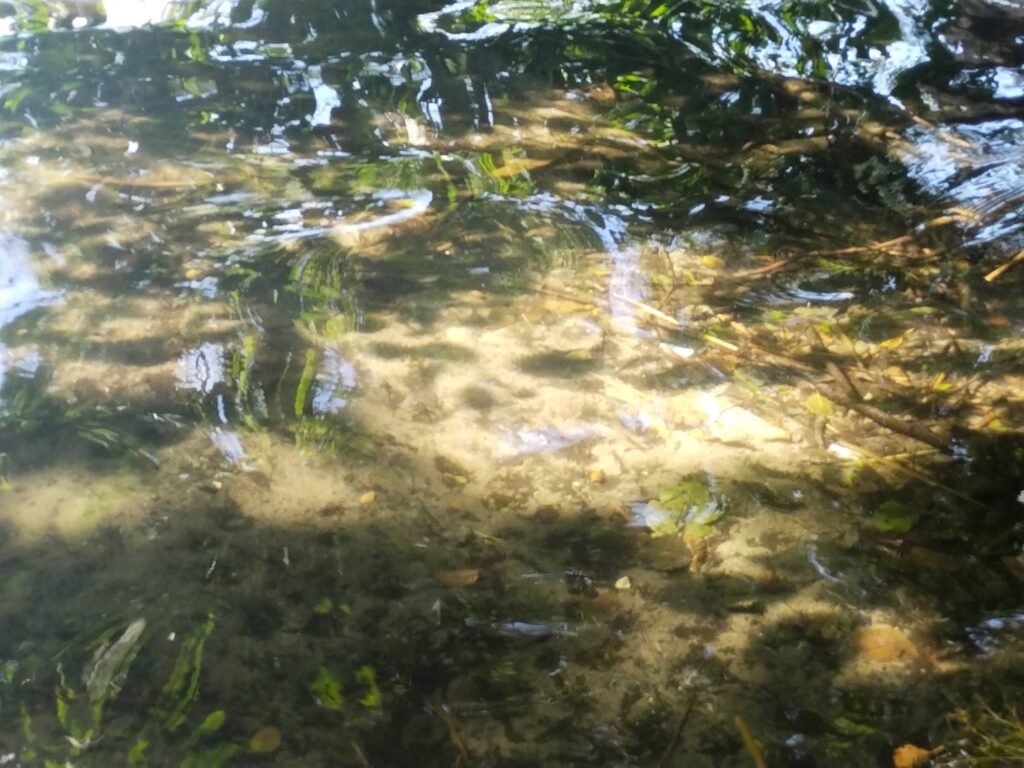Experiencing Caring Arts
by Fanny
Listen to the abstract of Experiencing Caring Arts by Fanny in English:
This text describes my experiences in the Caring Arts project. I write about what happened in our meeting in Munich in September and how I felt about it. I write from the perspective of January 2024, explaining what I learned and how it felt for me to be part of a space where people’s needs are important and taken seriously. This space was much slower than other spaces I am usually in. I realized in this process how often I adapt. Because I don’t want to disturb. That was painful to realize.
Click here to

It´s a picture by Fine that they painted at the Caring Arts Lab in Munich after going on Miri´s dream journey. Fine tells:
„I have painted a picture that shows a moment of caring.
It shows a footbath and arms washing legs in this footbath.
The background is white with many thin black lines reminiscent of waves. The picture has a black frame.
With the picture, I wanted to preserve the memories of the feelings from that moment.
I am at home with a friend and she is washing my feet and looking after me. At first I was ashamed because my feet were dirty and I didn’t like them, but then I felt very safe because she was taking care of me. The water is pleasantly lukewarm, the stone she uses to remove the calluses has a rough surface and scratches, but doesn’t hurt. Her hands are soft.
It was a very intimate moment. Maybe that’s why the black round footbath has the profiles of me and my friend on the top and bottom edges. At the time, I had a turquoise hairstyle with bangs. I also painted my lips turquoise. My friend had black hair and bangs at the time. I painted her lips an ultramarine blue color.
I wanted to show our bond through the colors. The water in the footbath changes color. The turquoise from me and the ultramarine blue from my friend run towards each other, spread out and mix in some places. This causes the colors to change their tones. I wanted to show how this connection came about.“
Listen to the audio version of Experiencing Caring Arts by Fanny in English:
Back to Munich again. The way from the hotel- where many of us are staying – to the venue where the lab is taking place is quite long. One person can sleep in the house where we meet every day. The others travel by bus and subway every day. We send updates about broken elevators and overcrowded trains. It’s still warm these late summer days in Munich. The room we’re working in is part of a shared housing project. It’s very bright and we’ve got cushions and blankets and beanbags. There is space to rest and relax if there are people who need it. I am excited to be part of this lab. I’m curious to see what will happen, where it will go on this journey we’ve embarked on together. We start working together in the afternoon and are in the room together for a few hours. I notice how the slowness gives me more space to relax and think differently about everything that has happened during the day.
We do rounds where we talk about our Access needs. It touches me to hear what the others in the room need to be able to be there. What they need to be able to participate and feel comfortable. I am touched by the vulnerability that people show in order to share what they need. It also scares me. It is so different, different from what I experience in my everyday life. In the individualistic world that tells me to take care of it myself. The fear of needing others: What if they’re not there? The fear is somehow there in the room and the conversations about it are not sought out by the non-disabled participants. On the last day, it is addressed, the desire for people to deal with this fear. One person says: “It is people’s fear that they themselves could become disabled, now or later in life. It shows the reality of how fragile and vulnerable our bodies are. Many people try to suppress this – as long as it doesn’t affect them.“
I am becoming more and more aware of how standardized and normed the world is. For me, standardized and normed means the idea that all people should conform to a certain way of being and behaving. This is usually not questioned or discussed. It is assumed that it is okay for everyone to sit on chairs. Or to only take a break every 2 hours. Or to work 8 hours a day. I realize how often I adapt to this unspoken expectations and then don’t look after my needs and make sure that I get what I need. And that there is often no room to ask for what one needs or negotiate it with others. I for example have a hard time concentrating for a long time. I need regular breaks. A few years ago I took part in a theater course where I felt safe enough to ask for what I needed. Sometimes the facilitators were responsive, sometimes not. At the same time, I was put into a box, I became the person who had a lot of needs and then asked for them. I did not like that role. I did not like getting attention because I asked for what I needed. After a while, I asked less about my need to have more breaks, it was too ex-hausting for me.
I made a very different experience in our first caring arts lab in Munich – and in the second one a year later in Vienna. Only then I realised how much I conformed to unspoken rules and norms. In our lab being a group did not mean that everyone had to have the same rhythm. A common rhythm is not the prerequisite for being able to be there. We also noticed this in some of the theater exercises that we tried out together. These exercises did not fit for some of us. By trying out different ways we managed to do it together without having to squeeze ourselves into a predetermined form. A form that doesn’t fit at all and that then causes some of us great pain.
I learned in this project : We need time. Time to talk, to exchange ideas, to reflect. Even if not so much happens outwardly, a lot happened inside of me during these lab days (and after-wards). Pain was coming up from understanding how often I accomodate and adapt to cer-tain expectations because I don’t want to disturb. I became aware of my own mechanisms and started to question a lot of things. I was thinking and feeling a lot of different emotions .
At the end, or in the middle, or wherever I am, I ended up having many more questions than answers.
How I can carry all this understandings and learnings into the rest of my life?
What needs to happen for other people to understand how important it is that we take care of each other and think about and include different needs and people into our spaces?
And then there is the feeling of always having to renegotiate how to create a caring space, since there is no recipe for this. Except perhaps time and listening and openness to doing things differently than we were taught.

It is a picture that I drew myself with a blue pen. On the white background is an abstract blue shape. There are several round angular bulges on the left and right sides.
It reminds me a bit of the letter U. It can also remind me of a whale. The part on the left looks a bit like a fish fin. It’s triangular and has a notch in the centre. The part on the right is like the open mouth of a whale. The shape also takes up the whole space of the picture like a whale when he comes to the water’s surface from the depths.
The shape has contours. I painted them in with the same colour. I coloured in the left part with lots of irregular small lines. The right part is rather smooth and even and slightly lighter in colour. At the bottom left is the blue overhead text in English: We carry each other. On the edge in the centre of the shape, the blue text is written in English from bottom to top: I carry you. On one edge on the right-hand side is the blue overhead text in Eng-lish: You carry me.
This picture gives me a sense of calm, just like the blue of the water. It also gives me a feeling of being held in the water.
Caring Arts erleben
Kurzfassung
Die Kurzfassung von Experiencing Caring Arts von Fanny auf Deutsch anhören:
Dieser Text beschreibt meine Erfahrungen im Caring Arts Projekt. Ich schreibe darüber, was in unserem Treffen in München im September passiert ist und wie es mir damit ging. Ich schreibe aus der Perspektive vom Januar 2024. Ich erkläre, was ich gelernt habe und wie es sich für mich angefühlt hat, Teil von einem Raum zu sein, in dem die Bedürfnisse der Personen wichtig sind und ernst genommen werden. Dieser Raum war viel langsamer als andere Räume, in denen ich sonst bin. Ich habe in diesem Prozess gemerkt, wie oft ich mich anpasse. Weil ich nicht stören möchte. Das war schmerzhaft zu merken.
Die Audioversion von "Caring Arts erleben" von Fanny auf Deutsch anhören:
München, September 2022. Wir treffen uns für das erste Caring Arts Lab in Präsenz. Ich bin aufgeregt. Nach so vielen Treffen online, wo wir gemeinsam das Projekt entwickelt und weiterentwickelt haben. Angefangen haben, uns kennen zu lernen. Wo wir Ideen ausgetauscht haben. Geteilt haben, was wir von dem Raum brauchen, was wir voneinander brauchen. Wo wir das Programm erstellt haben. Wo wir noch mehr Menschen eingeladen haben um mit uns gemeinsam zu der Frage zu forschen und sie besser zu verstehen: Was bedeutet denn care im Kontext von Kunst, von Theater machen, wie können wir einen Raum schaffen, wo die Fürsorge/Care Raum hat und in dem Bedürfnisse mitgedacht und erfüllt werden? Jetzt schreibe ich darüber und es ist Januar 2024. Es sind viele Monate vergangen und ich versuche mich zurück zu denken in die Version von mir, die damals existierte. Versuche mich zu erinnern was bei mir los war, was mich bewegte, und wie es mir ging. Ich versuche mich zu erinnern. Ich merke, dass viele Dinge, die ich im Lab und durch diese Zusammenarbeit gelernt habe, inzwischen in meine Arbeit eingeflossen sind. Dieses Wissen hat mich beeinflusst. Wenn ich Räume gestalte und halte, dann nehme ich mir heute mehr Zeit dafür. Ich arbeite oft mit Jugendlichen und wir machen zusammen Theater und Tanzen und sind kreativ. Ich versuche zurück zu denken und zu konzentrieren und so vieles um mich herum lenkt mich ab von diesem Versuch. So still zu sitzen fällt mir gerade schwer und in meinem Kopf und Körper streiten sich verschiedene Bedürfnisse.
Wieder zurück nach München. Der Weg von dem Hotel, in dem viele von uns übernachten zu dem Raum, wo das Lab stattfindet, ist relativ weit. Eine Person kann in dem Haus schlafen, wo wir uns jeden Tag treffen. Die anderen sind jeden Tag unterwegs mit Bus und U Bahn. Wir schicken uns updates über kaputte Aufzüge und überfüllte Bahnen. Es ist noch warm in den Tagen in München. Der Raum, in dem wir arbeiten, ist Teil von einem Gemeinwohnenprojekt. Er ist sehr hell und wir haben Kissen und Decken und Beanbags/ Sitzsäcke besorgt. So gibt es Platz, um sich auszuruhen und zu erholen, wenn es Personen gibt, die das gerade brauchen. Ich bin aufgeregt bei diesem Lab mit dabei zu sein. Ich bin gespannt was passieren wird, wo es hin gehen wird auf dieser gemeinsamen Reise, auf die wir uns begeben haben. Wir fangen die gemeinsame Arbeit am Nachmittag an und sind dann für einige Stunden gemeinsam im Raum. Ich merke, wie die Langsamkeit mir selber mehr Platz gibt zu entspannen und anders über alles nachzudenken und zu verdauen, was über den Tag so passiert ist.
Wir machen Runden, wo wir über unsere Access needs sprechen. Es berührt mich zu hören, was die anderen im Raum brauchen, um gut da sein zu können. Was sie brauchen um teilnehmen zu können und um sich wohl zu fühlen. Mich berührt die Verletzlichkeit, die Menschen zeigen, um zu teilen was sie brauchen. Es macht mir auch Angst. Es ist so anders, anders als das, was ich in meinem Alltag erlebe. In der individualistischen Welt, die mir sagt, ich solle mich selber darum kümmern. Die Angst davor andere zu brauchen: Und was wenn sie nicht da sind? Die Angst ist irgendwie da im Raum und die Gespräche darüber werden von den nicht-behinderten Teilnehmenden nicht gesucht. Am letzten Tag wird es angesprochen, der Wunsch, dass Menschen sich mit dieser Angst beschäftigen. Eine Person sagt: Es ist die Angst von Menschen, dass sie selber auch behindert werden können, jetzt oder später in ihrem Leben. Es zeigt die Realität wie zerbrechlich und verletzlich unsere Körper sind. Viele Menschen versuchen das zu verdrängen – so lange es sie nicht betrifft.
Mir wird immer mehr bewusst, wie normiert die Welt ist. Normiert bedeutet für mich die Idee, dass alle Menschen sich an eine bestimmte Art und Weise zu sein und verhalten anpassen sollen. Dies wird meistens nicht hinterfragt oder besprochen. Es wird davon ausgegangen, dass es für alle okay ist auf Stühlen zu sitzen. Oder nur alle 2 Stunden Pause zu machen. Oder 8 Stunden am Tag zu arbeiten. Mir wird klar wie stark ich mich oft auch anpasse und nicht nach meinen Bedürfnissen gucke und darauf aufpasse, dass ich bekomme was ich brauche. Und dass es oft keinen Platz dafür gibt, sie einzufordern. Ich kann mich nicht so lange am Stück konzentrieren und brauche regelmäßige Pausen. Vor ein paar Jahren habe ich an einem Theaterkurs teilgenommen, wo ich mich sicher genug gefühlt habe, um danach zu fragen, was ich brauche. Es wurde von den Leitungspersonen manchmal darauf eingegangen, manchmal nicht. Gleichzeitig wurde ich zu der Person gemacht, die viele Bedürfnisse hat und dann auch danach gefragt hat. Also es wurde so an mir festgeschrieben: ich bin die Person, die viele Pausen braucht. Nach einiger Zeit habe ich weniger nach meinem Bedürfnis gefragt mehr Pausen zu haben als eingeplant wurde, es war mir zu anstrengend. In unserem Lab in München – und in dem zweiten ein Jahr später in Wien – ist das anders. Es geht nicht darum eine Gruppe zu haben, in der alle den gemeinsamen Rhythmus haben. Ein gemeinsamer Rhythmus ist nicht die Voraussetzung dafür ist dabei sein können. Das merken wir auch in einigen Theaterübungen, die wir gemeinsam ausprobieren. Dass die Übungen für einige von uns nicht passen und dass es auch anders funktionieren kann, damit Menschen – oder wir hier in der Gruppe – uns nicht in eine vorgebebene Form reindrücken und quetschen müssen. Eine Form, die gar nicht passt und die uns dann auch große Schmerzen verursacht.
Wir brauchen Zeit. Zeit um zu sprechen uns auszutauschen, zu reflektieren. Auch wenn nach außen hin sichtbar nicht so viel passiert, passiert in diesen Tagen des Labs bei mir ganz viel. Es kommt Schmerz hoch wie oft ich mich anpasse, weil ich nicht stören will. Meine eigenen Mechanismen werden mir bewusst, ich hinterfrage vieles. Ich denke sehr viel nach.
Am Ende, oder in der Mitte, oder wo auch immer ich da gerade bin, habe ich viel mehr Fragen als Antworten.
Wie ich das alles in mein restliches Leben tragen kann.
Was es braucht, damit andere Menschen verstehen wie wichtig es ist, dass wir mehr aufeinander aufpassen und unterschiedliche Bedürfnisse und Menschen mitdenken und miteinbeziehen.
Und dann ist da noch das Gefühl von es immer wieder neu auszuhandeln, wie ein caring Raum gestaltet wird, denn es gibt kein Rezept dafür. Außer vielleicht Zeit und Zuhören und Offenheit dafür, Dinge anders zu machen als es uns beigebracht wurde.
About the author:
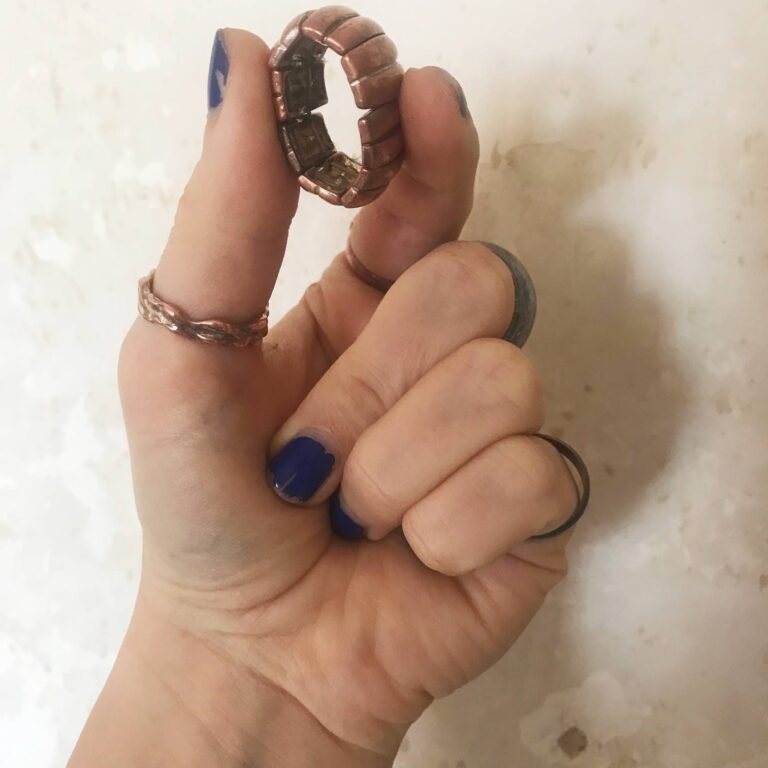
Fanny
The avatar is a photo of my left hand. I have an ultramarine nail polish on my fingernails and wear rings on my thumb, index finger, middle finger and little finger.
I hold a ring between my index finger and thumb. It’s a copper ring made up of several rectangles. I like to play with it. The different parts of the ring make a nice noise when they are moved against each other.
